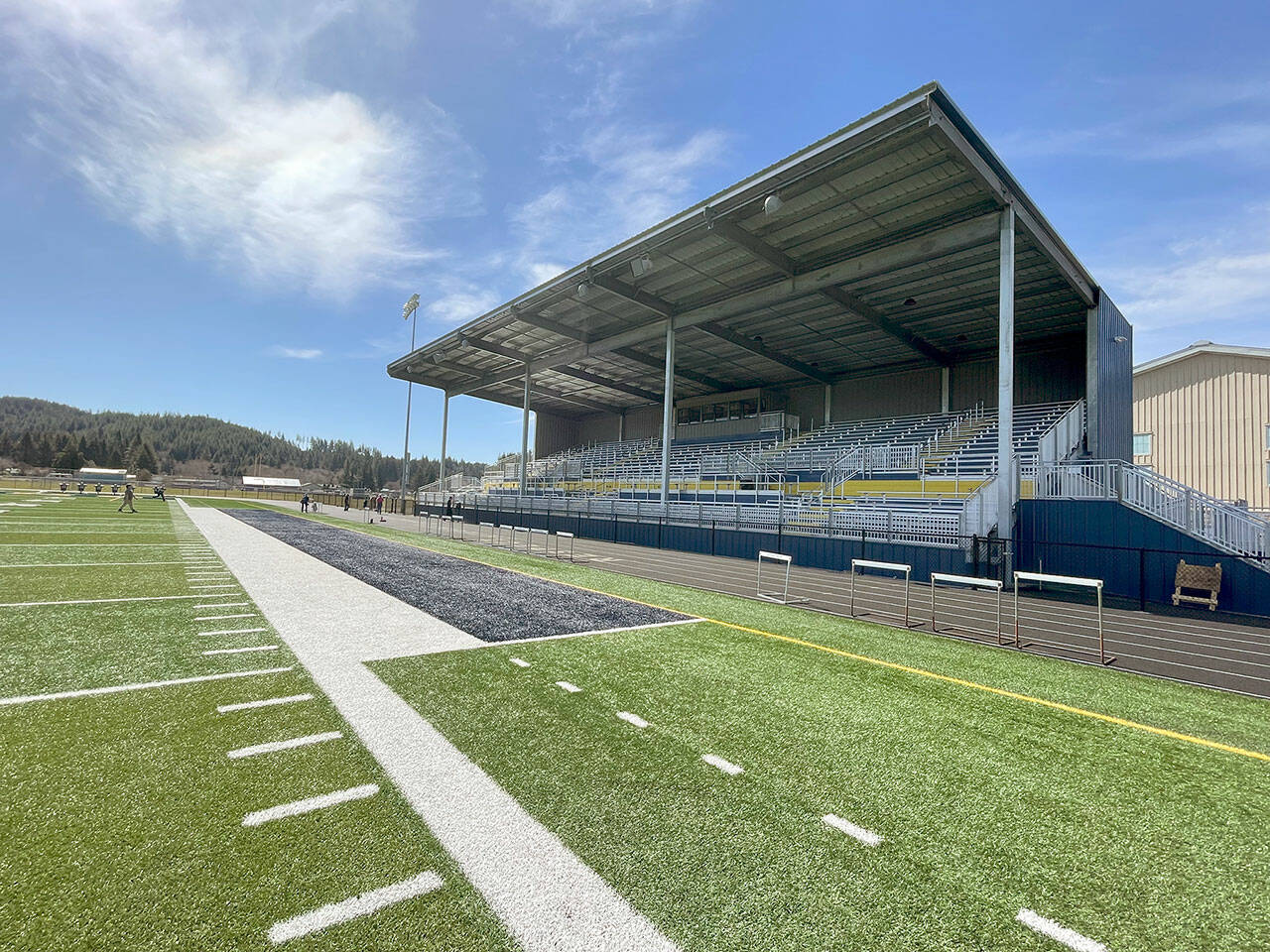FORKS — After an eight-month delay, Quillayute Valley School District’s new Spartan Stadium will open April 14 with a ribbon-cutting ceremony and a sigh of relief from Superintendent Diana Reaume.
The district had anticipated the facility would be ready the last weekend of October, but a series of delays related to weather and materials — from reduced availability to late deliveries to grandstand columns that were the wrong length — pushed the Phase I completion date to the middle of December, then to January and then again to March.
The restrooms that are part of Phase II won’t be finished until the end of the year, but the stadium painted Spartan blue and gold will be ready for its official debut.
“We’ve had a lot of compliments from the crew,” Reaume said. “They’ve put up thousands of structures and they were very complimentary of not only our field, the view, the quality of the steel. It really went pretty well other than it took much longer than we thought.”
The Spartan Stadium ribbon-cutting ceremony will be at 5 p.m. April 14 before the Forks High School boys varsity soccer game against Eatonville starts at 6 p.m.
Renovation of the entire Spartan Stadium facility began in 2016, when the district replaced the grass field with artificial turf at a cost of $1.3 million. That is now matched by a 1,136-seat aluminum structure designed by BLRB Architects of Tacoma.
The facility is a significant improvement over the old Spartan Stadium, which Reaume said was built in 1962. Unlike its wood predecessor, the new stadium’s roof covers the entire seating area, it has a press box, plenty of electrical outlets and wifi connectivity. Announcements and music played over the sound system are clear and loud, not fuzzy and muffled.
“We will be heard by the neighbors for sure,” Reaume said.
The new standalone ticket booth will take only cash at present, but the district is vetting vendors to handle e-ticketing, credit card purchases and mobile payments (like Apply Pay and Google Pay).
Two soft openings, a 10-team track meet and a soccer game, enabled the district to test the sound system, monitor foot traffic and identify any potential problems. The most notable takeaway was one the district had already anticipated and couldn’t fix anyway: Forks’ weather.
“The track meet was a challenge, it was pouring, freezing rain and the weather pattern in that section [on the south side of the stadium] was pretty wet, but there’s not a lot that we can do about that,” Reaume said.
Reaume said the stadium’s ADA-compliant features like switchback ramps to the bleachers and wheelchair seating and companion seats attracted people who had been unable to attend events at the old stadium, which could be accessed only by stairs.
“What I noticed at both the soccer game and the track meet, there were a lot more of our elderly community members,” Reaume said.
Another observation: the aluminum bleachers are a little chillier on the backside than the old wood ones, so Reaume recommended “bring a blanket to sit on.”
The stadium’s most eye-catching feature is a 96-foot-long, 6-foot-high gold illuminated Spartan Stadium sign on its west side. The $101,975 sign was fabricated in Tennessee and transported to Forks, where Hanson Signs of Silverdale installed it earlier this week.
“We’re the first K-12 school that has anything like it in the state,” Reaume said. “It’s our signature.”
A 14-foot-high, 10-foot-wide gold Spartan logo decorates the stadium’s north side. New fencing was installed around the stadium itself, and replacement fencing will surround the entire facility.
Funding
Both Phase I and Phase II of the project are being funded through timber dollars and grants, so the district did not have to go to the community for financial support through a bond or levy.
The district and board made clear to BLRB their desire for a cost-effective design that was functional, used high-quality materials and did not duplicate amenities that already existed. The goal was a facility the entire community could use and enjoy for the next 50 years.
The stadium does not have a concession stand or locker rooms, for example. Bill Henderson, maintenance and facilities manager for the Quillayute Valley School District and the project manager, said not only was constructing them cost-prohibitive, but it didn’t make sense when concessions could be sold from the existing concession stand and student-athletes could use the existing locker rooms at the high school, much of which was replaced when construction was completed in 2012, and is just steps away.
The district instituted a number of cost-saving measures to keep down stadium construction costs. Bringing project management in-house instead of hiring an outside project manager saved about $300,000, for example.
Nonetheless, cost overruns have bumped the price tag from $2.6 million to $3.2 million.
“We going to do a budget extension because we can never spend more than we say we’re going to spend,” Reaume said. “Some things have gone over mainly because we didn’t get everything we wanted to last summer and it pushed the costs into this year’s budget.”
That the stadium has already become a popular destination for sports, play and physical activity, Reaume said, reflects its value as an investment from which the entire community is benefiting.
“There are kids out there playing football, soccer; there’s adults walking the track. I mean, it really is used quite a bit,” Reaume said.
________
Paula Hunt can be reached at 360-425-2345, ext. 50583, or by email at paula.hunt@peninsuladailynews.com.

